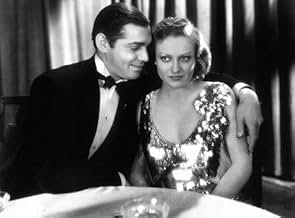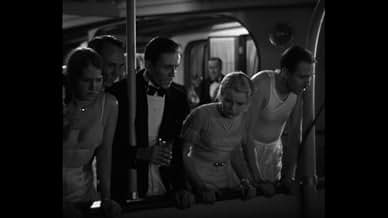Ajouter une intrigue dans votre langueAfter the death of her father and loss of the family fortune, Bonnie (Joan Crawford) gets a job as a cub reporter while her brother (William Bakewell) becomes involved in bootlegging.After the death of her father and loss of the family fortune, Bonnie (Joan Crawford) gets a job as a cub reporter while her brother (William Bakewell) becomes involved in bootlegging.After the death of her father and loss of the family fortune, Bonnie (Joan Crawford) gets a job as a cub reporter while her brother (William Bakewell) becomes involved in bootlegging.
- Réalisation
- Scénario
- Casting principal
- Récompenses
- 1 victoire au total
- Wally
- (as Earl Foxe)
- Parker
- (as Purnell B. Pratt)
- Luva's Henchman
- (non crédité)
- Albert
- (non crédité)
- Yacht Waiter
- (non crédité)
- Clinton
- (non crédité)
- Chorus Girl
- (non crédité)
- Reporter
- (non crédité)
Avis à la une
The other option for employment seemingly was to become a journalist - perhaps not such an easy option but unlike her brother's unwise career plan, that's what Joan Crawford's Bonnie does when they become broke. Incidentally, women journalists and women writers, especially in Hollywood, although the exception were not that uncommon. Indeed the writer of this film, Aurania Rouverol, was a noted female playwright.
As a work of fiction, this is perhaps Miss Rouverl's greatest achievement. The plot is quite nonsensical but in the magical hands of Irving Thalberg's team at MGM, you're swept along with this stupid story, accepting it all as perfectly normal.
MGM was the last of the studios to make the switch from silents to sound and as such talking pictures were still a novelty to the studio when this was made. This is very much evident with this. The most sophisticated and classiest silent films were often from MGM and they couldn't abandon that style they'd built up over all those years so easily. Like in the 20s, in this film, faces and expressions are used to tell the story and nobody was better at that than Joan Crawford. The story allows her to really develop her character and her experience one of the leading silent stars ensures first rate acting.
Clark Gable, in one of his very first roles is only swaggering around for about twenty minutes but he makes quite an impact. Although he is a one-dimensional nasty piece of work, he has an electrifying presence. His on-screen (and subsequent off-screen) romance with Miss Crawford also gives this film an authentic undercurrent of sexual tension. This and the overall high standard of acting (much better than in some other offerings from 1931) again helps to keep this crazy plot seem real. Even so, as a motion picture, it doesn't quite hit the mark but is nevertheless still entertaining.
You can probably guess what I love about Crawford's character. She's a modern woman who looks great out on the dance floor, believes in "trying love out on approval" (a scene which clearly signals pre-marital sex), and would rather work and be independent than settle for the traditional role of wife. Her brother is incredulous, leading to this exchange:
Bonnie (Crawford): "I'm not going to do any of those stupid, silly, conventional things. You'd be surprised what a girl can earn when she sets her mind to it. I'm no dud." Rodney (Bakewell): "You've got the looks, kid. Trade on 'em. Open up a beauty parlor. ..." Bonnie: "That's your idea of me, huh? Beautiful but dumb. All right, I'll show you. I'm going out to get a man-sized job."
That second dance she does when she's working undercover in the gangster's nightclub to get a story is delightful and evokes the flapper era, but to me the feminism in the film is what makes it a solid film, despite its basic plot. Crawford is not known for her on-screen charm, but she summons it here, and does well in the various aspects of her role - society woman, flapper, newspaper reporter, and love interest (hey, the complete woman). Gable is suitably tough as the gang leader, and he and Crawford have great chemistry together. I didn't care for the contrived confrontation which occurs and how the film ends though, which was really unfortunate, and kept it from a higher rating.
Another quote, from Gable to Crawford after her dance: "You got me going, sister." "Can I depend on it?" "In a big way."
The film is largely an unremarkable morality tale about the follies of the very wealthy spoiling their children even into adulthood to the point where they complain about having to "get up in the middle of the night (9 AM) to eat breakfast.", which are the sentiments of the two Jordan children. When Wall Street crashes, dad dies from the shock and Bonnie Jordan (Joan Crawford) and her brother are left penniless. Bonnie chooses to break into newspaper reporting, but her brother chooses a less honest option which brings him into contact with Gable the gangster. After her close friend, reporter Bert Scranton (Cliff Edwards), is shot to death, Bonnie decides to go undercover as a dancer at Gable's nightclub to try to get to the bottom of the murder. She solves the crime, but at great personal cost.
The best parts of this film are watching Joan Crawford in a dance number and watching the great chemistry Crawford and Gable have together. You get bigger doses of Crawford and Gable together in "Possessed", which was made later this same year - 1931. Joan Crawford was already a big star at this point. As for Clark Gable, he has to wait until he manhandles Norma Shearer in "A Free Soul" before he catapults to true stardom.
Middle-of-the-road crime drama will appeal most to fans of Crawford and Gable. It's hardly the best work of either, though. It's a pre-Code film, which sometimes is all you have to say to get some classic film fans interested in a movie. Personally I didn't see anything all that risqué in this one. An early scene of a bunch of people in their underwear going for a swim seems to get the most talk but it's pretty tame despite the description. The story is something that was done many times and better over the years, in one variation or another. The insipid romance between Joan and Lester Vail leaves a lot to be desired.
But none of this is supposed to be taken seriously - it's all good fun from those wonderful pre-code days, when Hollywood was really naughty. Joan looks great, and displays much of the emotional range that would give her career such longevity (thank God she stopped the dancing!). Gable is remarkable as a slimy gangster - he wasn't a star yet and so didn't have to be the hero. Great to see him playing something different. And William Bakewell is excellent as the poor confused brother. And there are some great montages and tracking shots courtesy of director Harry Beaumont, who moves the piece on with a cracking pace - and an occasional wink to the audience! Great fun!
Le saviez-vous
- Anecdotes"Dance, Fools, Dance" is clearly based on two infamous incidents in Chicago crime history: the 1929 St. Valentine's Day Massacre in a garage and the June 9, 1930 murder of Chicago Tribune reporter Jake Lingle, who was shot while heading to a train station. However, unlike the movie's Bert Scranton, Lingle was a shady character who played both sides of the law and had parlayed a $65 a week salary into a $60,000 income. In journalistic terms, Lingle was known as a legman who would telephone in the salient details of the story which would be actually written by a rewrite man. This is what happens when Joan Crawford's Bonnie phones in her story after the shootout.
- GaffesWhen in the newsroom Scranton tells Bonnie that if they had a chance they would cut the Lord's Prayer to a one-line squib and he quotes, "Now I lay me down to sleep". But the line is not from the Lord's Prayer, it is actually the first line and title of the bedtime prayer, "Now I Lay Me Down To Sleep".
- Citations
Bob: You know I'm very much in love with you, don't you?
Bonnie: Are you?
Bob: I'm crazy about you, and you know it.
Bonnie: I didn't know.
Bob: Well, you know it now. What about it?
Bonnie: That's it... what?
Bob: Going to make me stand on ceremony?
Bonnie: You think I'm so old-fashioned?
Bob: I hope not.
Bonnie: You're right. I'm not. I believe in... in trying love out.
Bob: On approval?
Bonnie: Yes, on approval.
[they kiss as the scene fades out]
- ConnexionsEdited into Hollywood: The Dream Factory (1972)
- Bandes originalesPiano Sonata No. 14 in C sharp minor, Op. 27 No. 2 'Moonlight'
(1800-01) (uncredited)
Written by Ludwig van Beethoven
Played on piano by Natalie Moorhead
Reprised on piano by Joan Crawford in a swing version
Meilleurs choix
Détails
- Date de sortie
- Pays d’origine
- Langue
- Aussi connu sous le nom de
- Dance, Fools, Dance
- Lieux de tournage
- Société de production
- Voir plus de crédits d'entreprise sur IMDbPro
Box-office
- Budget
- 234 000 $US (estimé)
- Durée1 heure 20 minutes
- Couleur
- Rapport de forme
- 1.20 : 1
Contribuer à cette page




































